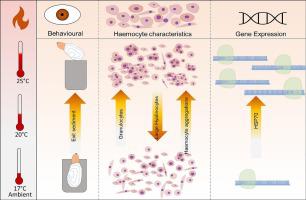Comparative Biochemistry and Physiology B: Biochemistry & Molecular Biology ( IF 2.2 ) Pub Date : 2023-08-11 , DOI: 10.1016/j.cbpb.2023.110892 Shaneel S Sharma 1 , Leonie Venter 1 , Emily J Frost 1 , Andrea C Alfaro 1 , Norman L C Ragg 2 , Leonardo N Zamora 2

|
Climate extremes, such as heatwaves, are expected to become more intense and of longer duration in the near future. These climatic conditions may have a significant impact on the prospects of establishing a new aquaculture industry for the endemic New Zealand geoduck, Panopea zelandica. This study focused on characterising animal behaviour, haemocytes , and heat shock protein (HSP70 & HSP90) mRNA expression following exposure to elevated temperatures, such as those encountered during marine heatwaves around 20 °C and an extreme scenario of 25 °C, contrasted to an ambient temperature of 17 °C. After 24 h of heat challenge, P. zelandica were found to be significantly influenced by the thermal changes, as there were differences recorded in all the responses examined. With increasing temperatures, juvenile geoduck were observed to fully emerge from the sediment a behaviour that has not previously been quantified nor associated with stress in this species. The ability of P. zelandica juveniles to re-bury still warrants further investigation, as adults are unable to do so. Haemocyte analyses revealed an increase in the abundance of granulocytes, cellular aggregations, and size of these aggregations at the highest temperature exposure. Increased expression of the hsp70 gene in the haemolymph after exposure at 25 °C for 24 h was detected and attributed to attempts to mitigate protein denaturation caused by thermal stress. The inter-individual variability in the response of heat shock proteins recorded could aid in future selective breeding programs if it is reflected in net thermotolerance. P. zelandica shows great potential for growing in subtidal habitats around New Zealand, and this study highlights the importance of temperature considerations when selecting potential farm and reseeding locations.
中文翻译:

急性热应激后幼年象拔蚌(Panopea zelandica)的行为和生理反应
预计在不久的将来,热浪等极端气候将变得更加强烈、持续时间更长。这些气候条件可能会对新西兰特有象拔蚌Panopea zelandica建立新水产养殖业的前景产生重大影响。这项研究的重点是表征暴露于高温后的动物行为、血细胞和热休克蛋白 (HSP70 和 HSP90) mRNA 表达,例如在 20°C 左右的海洋热浪和 25°C 的极端情况下遇到的情况,与环境温度17°C。经过 24 小时的热挑战后,发现泽兰白杨受到热变化的显着影响,因为所有检查的反应都记录有差异。随着温度的升高,幼年象拔蚌被观察到完全从沉积物中显现出来,这种行为以前从未被量化过,也与该物种的压力无关。泽兰迪卡幼虫的重新埋葬能力仍值得进一步研究,因为成年虾无法做到这一点。血细胞分析显示,在最高温度暴露下,粒细胞丰度、细胞聚集以及这些聚集的大小增加。在 25°C 暴露 24 小时后,检测到血淋巴中hsp70基因的表达增加,这归因于试图减轻热应激引起的蛋白质变性。所记录的热休克蛋白反应的个体间差异如果反映在净耐热性中,可能有助于未来的选择性育种计划。P. zelandica在新西兰周围的潮下生境中显示出巨大的生长潜力,这项研究强调了在选择潜在农场和重新播种地点时考虑温度的重要性。



























 京公网安备 11010802027423号
京公网安备 11010802027423号